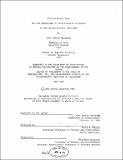William Robert Ware and the beginnings of architectural education in the United States, 1861-1881
Author(s)
Chewning, John Andrew
DownloadFull printable version (31.78Mb)
Alternative title
Beginnings of architectural education in the United States, 1861-1881
Other Contributors
Massachusetts Institute of Technology. Dept. of Architecture.
Advisor
Henry A. Millon.
Terms of use
Metadata
Show full item recordAbstract
William Robert Ware (1832- 1915) planned and directed the first collegiate program in architectural education i n the United States. He was educated in the liberal arts and civil engineering at Harvard University and received further training in architects' offices before entering into practice with Henry Van Brunt (1832-1903). In 1865 Ware was appointed to the newly established Massachusetts Institute of Technology. He remained on the faculty until 1881, when he was called to Columbia University to organize still another collegiate program in architecture. During 1866-67, Ware traveled in Europe, paying particular attention to the role of national schools and professional organizations in the teaching of architecture in Britain and France. Formal instruction in architecture at M.I.T. began in the fall of 1868. Ware devised a curriculum, which he adjusted throughout the 1870s, including drawing and design, architectural history, and construction and practice (i . e., building materials and components, specifications, and contracts). In the spring of 1872, he recruited Eugene Letang (1842-1892), an alumnus of the Ecole des Beaux-Arts, to teach design. From this time on, the routine studio problems at M.I.T. began to emulate those of the Ecole, and the eclectic neoclassicism of the Beaux-Arts began to predominate in students' drawings. The Department of Architecture at M.I.T. in these earliest years functioned best in providing a one- or two-year course of special study for persons who were graduates of four-year colleges or who had some experience in architects' offices. It also served to prepare Americans for the formal or informal study they intended to pursue in Paris. Ware's department offered, in effect, a postgraduate program, a program in continuing education, and a preparatory program for advanced study at the Ecole des Beaux-Arts. By virtue of its location in cosmopolitan Boston, the M.I.T. Department of Architecture emerged in the 1870s as the preeminent American collegiate program, attracting more students from more diverse parts of the country than the other important early programs at Cornell University and the University of Illinois. Ware trained some 235 students at M.I.T., and many of them became the leaders in architecture and architectural education in the late nineteenth and early twentieth century.
Description
Thesis (Ph. D.)--Massachusetts Institute of Technology, Dept. of Architecture, 1986. MICROFICHE COPY AVAILABLE IN ARCHIVES AND ENGINEERING. Bibliography: leaves 482-490.
Date issued
1986Department
Massachusetts Institute of Technology. Department of ArchitecturePublisher
Massachusetts Institute of Technology
Keywords
Architecture.